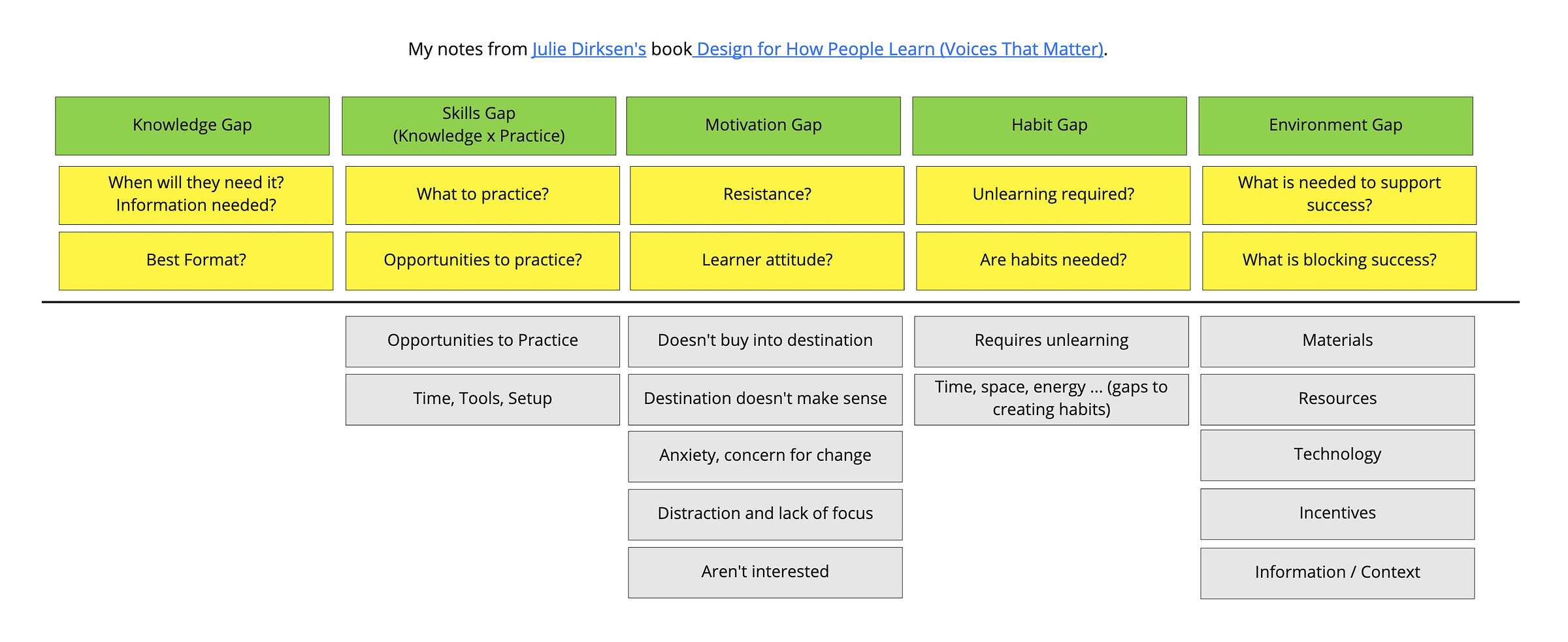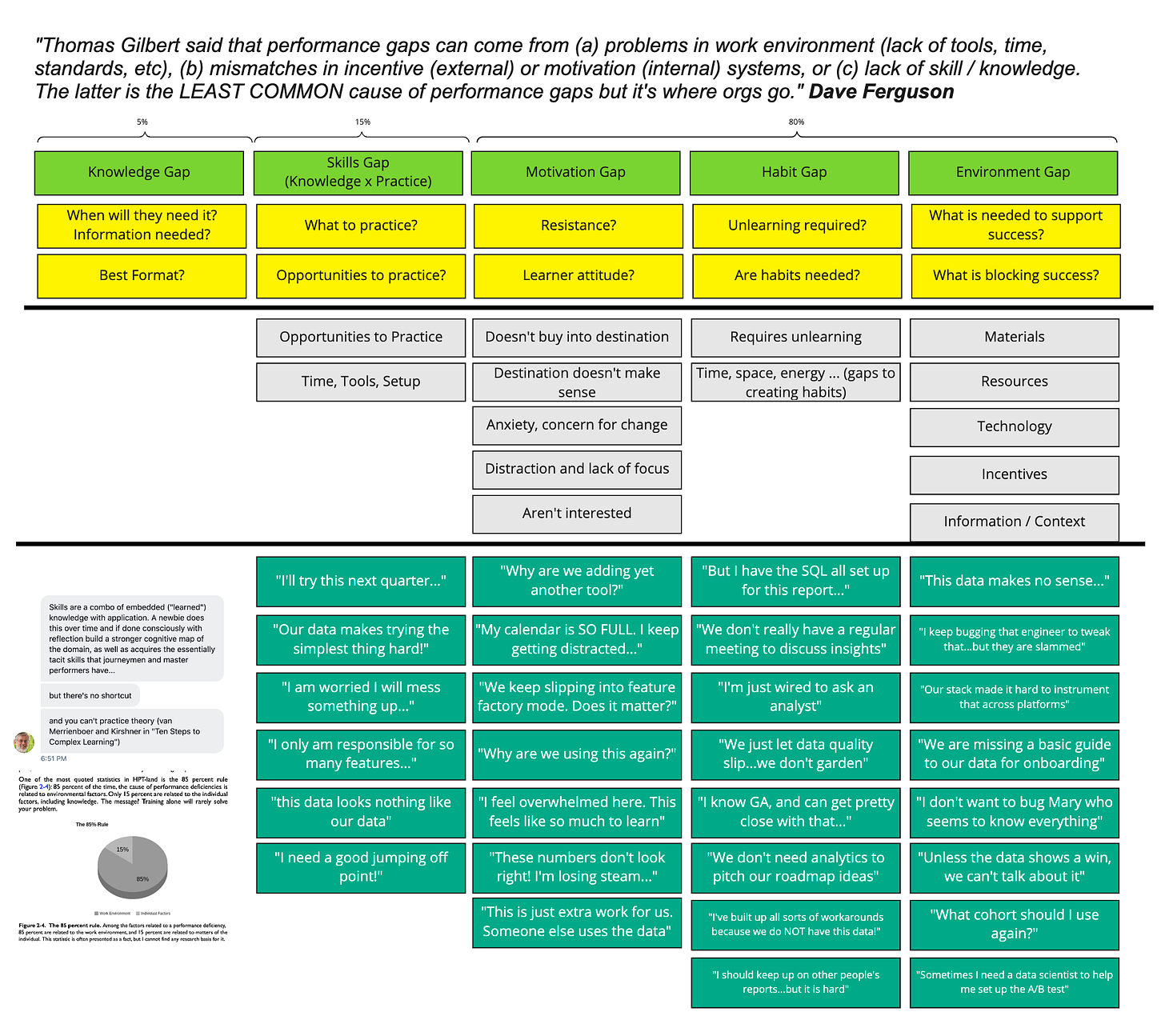Some News
Amplitude has some cool live (free) courses. Check the calendar.
I did a talk recently that I am happy about called Focus First, Then Simplify. Check it out. It expands on an earlier post by the same name.
I wrote a checklist to consider when putting together a “plan on a page”.
My talk on Drivers, Constraints, and Floats is available on demand (free). I’m proud of the talk. If you want a sneak peek of the Miro board used in the talk look here.
Here’s my favorite slide from the talk:
Sound familiar?
The team knows that learning reviews, one-pagers, continuous roadmapping, and data jams are valuable, but we can't make it work. Are we doomed to short-termism and focusing on reactive fires?
Great question.
In the insightful (and accessible) book Design for How People Learn, Julie Dirksen covers five "gaps" that inhibit learning (and applying) something new:
Knowledge Gap
Skills Gap (Knowledge + Practice)
Motivation Gap
Habit Gap
Environment Gap
I made this diagram of the five gaps:
When viewed through the lens of these gaps, it becomes obvious why proactive "nice to have" practices tend to fall by the wayside. Spoiler! Knowledge is just a tiny part of the puzzle (especially for aspirational practices).
Let's imagine an example. A team wants to build a new habit around a continuously updated information radiator (e.g., current strategy, up-to-date roadmap, review of recent efforts and outcomes, etc.). Sounds helpful! Let's do it!
But consider this list of blockers:
Communicating this way takes practice. Business-as-usual consumes everything.
Extra scrutiny can be demotivating and disempowering.
"It just feels like extra work! When does anyone have the time to do this?"
There are fires to put out that require more attention.
People say they will check these asynchronously. But will they?
It can be hard to flip to this more reflective work when deep in doing mode.
There's a lot of skepticism about anything not related to current work.
Making uncertainty visible—not knowing—requires trust and safety.
It is manual and time-consuming to update the board manually.
This idea assumes that context and information are available to keep a strategy current.
Something seemingly helpful—and probably a good habit for the team to develop—is fraught with issues. How often has your team done a retrospective and proposed a good idea, only to find things fade quickly?
The optional things that are good for us are the hardest! Meanwhile, all the bad habits that happen automatically every day are nearly impossible to break.
Forming habits is well-trodden territory. I am not an expert. But in chatting with teams, I have noticed some things that seem to work when developing new "optional" habits.
Put prep on the calendar during business hours (Environment).
Agree on what things you will STOP to make room for the new thing (Motivation, Habits, Environment).
Give it an expiration date. Reassess the experiment on that date (Motivation).
Hack an existing ritual, and take 5 minutes to review the information radiator (Habit, Environment, Motivation, Skills/Practice).
Have more experienced people "pair" with new team members and work together (Knowledge, Skills/Practice, Motivation, Environment).
Agree to pause the ritual during the busiest times in the quarter/year (Motivation, Environment).
Continuously ask how the activity could be more valuable. Don't just launch something and keep it static (Motivation, Environment).
Every 6-8 weeks, do a "strategy day" to share any new context (Environment, Motivation).
Figure out how to use technology to keep the radiators updated (Environment, Motivation).
Leaders follow through. All too often, it is the manager/leader who doesn't have time to do the practice. They don't model how it is done (Skills, Motivation, Habits, Environment).
When I create lists of options like this with teams, the first response is often:
"Oh my god, this is WAY harder than we thought! You're right. We've had good ideas like this over and over, and nothing has stuck!"
Your biggest lever is the size of the experiment. A "continuously updated information radiator (e.g., current strategy, up-to-date roadmap, review of recent efforts and outcomes, etc.)" is a big undertaking. How could you trim this down?
The key thing to remember is that we tend to focus on knowledge and cursory motivation. There’s a lot more to it.
Want to see something neat? You can use these gaps for your product as well. Here’s an example brainstorm for a data/analytics product.







Great post. Highlights the importance of selecting the right problem to focus on and to limit WIP on other ones. Setting a clear start and end date is crucial when running these experiments in my experience as described in the article.
Reading the book now. Thanks John.
It's an eye opener for some that see now a more complex set of issues involved.
In practice though the team leader, CPO or similar, has to invest tones of time and energy to make it work through all the resistance and passive-aggressive behavior or people who, naturally, don't want changes and wired to seek for homeostasis.